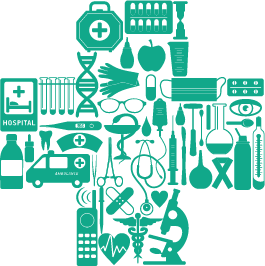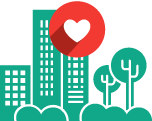Let's talk
Reach out, we'd love to hear from you!

Have you ever missed a doctor’s appointment because you had a client meeting? Diagnosis of symptoms at an early stage helps your doctor prescribe accurate medication in order to treat the health issue. Why don’t you consider taking the help of emerging technologies like Big Data, IoT, Cloud Computing etc. to stay updated about your current health condition?
Technologies Transforming Global Healthcare Solutions
Public clouds push and pull data in a two-way process to our smart devices in daily use. Internet of Things (IoT) partially connects relevant industry-related information that will help consumers arrive at customized and better decisions.
Technologies like machine learning and big data help service providers to diagnose and prescribe proper medication in advance. Personalized diagnostics or a complete course of medication is the current scope of machine learning.
Data analytics offers several opportunities that support healthy behaviors. Health analytics help healthcare providers engage and support individuals outside the clinic. Analytical tools guide patient’s behavior, rather than simply tracking it, giving individuals specific instructions to develop and maintain healthy behaviors.

Significant advances have been made in this field for curing and managing diseases, extending life expectancy and improving overall quality of life. If you think all is good, you are partially right; actually new challenges are presented often.
The average life expectancy of humans is increasing; long-term health conditions demand continuous monitoring and ongoing treatment. These demands put additional pressure on already stretched healthcare systems and ever-increasing costs. The need of the hour is a solution for streamlining and lowering the costs of healthcare monitoring and delivery as well as improving the overall quality and making it accessible and convenient to patients.
Healthcare and Connected Devices
Industry experts such as Gartner predict that by 2020 more than 25 billion devices will be connected through IoT. How many will be medical and/or monitoring devices? Several wearable devices track heart rates, weight, quality and amount of sleep, daily steps, and intensity level of workouts; individuals pay close attention to these facts and manage their health actively using wearable devices.
People suffering from ill health conditions, use sophisticated monitoring devices to monitor and report levels of blood oxygenation, hydration, lung capacity, blood sugar levels, Body Mass Index (BMI), mood swings and also capillary blood flow.
The ability to dispense, adjust and control medication dosages is now available in the form of smart pill bottles. Finally, physicians are using their smart, mobile devices to deliver healthcare and even dictate “visit” summaries that are converted to text and stored in patient electronic medical records as part of their medical history.

Access to healthcare advancements allows more people to properly follow daily routine and activities. Moreover, you can manage your health conditions from your home instead of visiting a hospital. Now, you can improve your overall quality of life with the help of IoT devices and other smart technologies.
Not only individuals but even healthcare providers can efficiently provide healthcare services using these devices. They are able to monitor patients, adjust medications and treatments from a remote location, thus improving the level of healthcare delivered to a greater number of patients simultaneously. You are able dictate doctor visits and discharge summaries thereby ensuring up-to-date electronic medical records.
You can also take the help of a managed services provider to digitally transform your healthcare solutions.
Healthcare and Big Data
Big Data has immense potential to transform the healthcare industry; big data tools collect billions of data points which can be used for health management in three key areas:
Descriptive analytics measure what has happened, such as frequency, costs, resources. Predictive analytics uses the descriptive data to forecast likely outcomes in the future. Prescriptive analytics provides the capability to make proactive decisions considering preempting predictions.
Uses
- Identify potential localized outbreaks of illness and epidemics
- Improve diagnostic accuracy
- Create personalized treatment plans
- Reduce infection rates
- Provide advanced decision-making support
Another example is use of socioeconomic data for determining likelihood of people actually coming for their appointment. Some clinics and hospitals arrange and pay the taxi fare to ensure the patient comes for the follow-up surgery appointment rather than letting the health condition worsen up to a point being re-hospitalized. In this way, the patient saves several dollars and comes for the appointment on time.
Healthcare and Smart Cities
Health experts predict urban residents to account for 70% of the total global population by 2050. Smart Cities will play an important role in the enhancement of healthcare services on the global front.
Advanced sensors will generate continuous information on the following aspects:
- Pollution
- Noise
- Light
- Traffic
- Pollen
- Humidity
- Temperature

Live data prepares the base of a smart city; hence, such cities can develop exclusive health applications in order to provide continual alerts and advice for its citizens. For example, when existing quality of air has negative effects on already known health conditions, apps will guide citizens to take alternative routes in order to avoid certain regions of the city.
Health apps linked with a monitoring device is instrumental for a physician because you can modify a medical dosage on the basis of the patient’s daily routes and activities.
Smart Cities are implementing systems that offer a viable option to the elderly patients to be treated whilst in their homes. A smart healthcare system will include a table, Skype connection, and inexpensive wireless sensors for remote-healthcare providers to communicate with patients; they can monitor their health condition and send safety notifications in situations like a door is open at night, or a stove is on for 15 minutes and more.
A majority of healthcare providers are exploring options to find tools and technologies that will empower them to participate in basic big data activities, like risk stratification, population health management, and reducing operational costs. However, providers adopting cutting-edge technologies have gone past the first stage already and heading towards the future by embracing big data. Few of these trends that will transform future of healthcare industry include:
1) Change in the diagnostic landscape
The diagnostic landscape is changing with the potential of big data technologies. Clinics and healthcare providers have access to improved interpretation of x-rays, CT scans, and MRIs. Until now, it was the domain of skilled clinicians who specialized in identifying abnormalities in research findings.
Computing technologies and higher analytics algorithms can now identify patterns through digital images, thus adding a new dimension to the diagnostic process and expanding the potential of big data and its aspects for transforming patient care.
2) Personalized healthcare treatment
This vision combines the principles of data science and medical science. Personalized healthcare aims at providing enhanced and relevant healthcare services to individuals and communities. A tailored regimen will be prescribed according to the patient’s medical, physical, and environmental conditions.
Personalized healthcare will avoid conditions of overdiagnosis, i.e. every patient undergoes rigorous treatment without considering the individual conditions. For example, the John Hopkins University has implemented the system of personalized healthcare for individuals.
3) Wearable and IoT gadgets revamp patient-centric care
Patient-centric healthcare is evolving as an industry game-changer since consumers have adopted wearable technology such as tools for home monitoring and mobile health apps like Apple’s FitBit or Health Tracker for Android users.
The Internet of Things (IoT) eliminates barriers preventing patients from timely care. It is not easy to visit a doctor every time. You often cancel the appointment due to work, family or leisurely activities. So, often you avoid going to the doctor.
IoT will come to your rescue. Now, doctors will use the sensor data to monitor their patients from remote locations. You can register for a remote health checkup through live streaming of health videos provided by your doctor. Thus, doctors use data-driven insights to reduce the likelihood of severe health conditions going unnoticed.
Smart sensors and connected devices will help doctors quickly identify medical abnormalities and accidents. For example, if an elderly patient falls at home, an alert will be sent to the doctor and an emergency medical team will be sent to the site for immediate assistance.
Doctors will also receive accurate information about the critical conditions of a patient if a patient is in transit during an emergency.
4) Cognitive computing and machine learning
Cognitive computing is an extremely powerful tool that helps medical researchers find solutions to life-threatening diseases. However, they require assistance with practical applications of solutions having embedded cognitive computing capabilities.
Cognitive computing refers to an enabler that will quicken the process of research and thinking; it is a mechanism to arrive at diagnostic solutions quickly. Clinicians can now develop innovative solutions and arrive at conclusions faster. It is also a cost-effective method of diagnostics. 
Health-related data is derived from several sources; clinical data, physiological data, lab data, actuarial data, and consumer data. Machine learning techniques create a unified platform for integrating these varied forms of data.
Wearable technologies help in monitoring patient activities like air-quality at home, humidity, number of times he/she used the toilet, etc. it helps in deriving a robust image of individual trends across diverse populations.
Application of machine learning techniques to such data helps clinicians and doctors make an accurate diagnosis; they are able to predict the health condition at an early stage and can intervene during the initial stages of ill health. They can also refer to historical medical data related to clinical assessments, lab values, etc to create a continuous data inflow to implement changes quickly.
